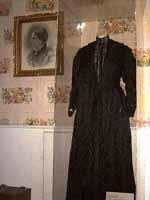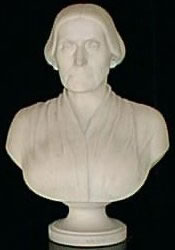Photo Gallery
Susan B. Anthony, pioneer leader for women's rights, lived in this house at 17 Madison Street in Rochester, NY, from 1866 until her death in 1906. When she was not crisscrossing the county campaigning for woman suffrage, she was here, writing and organizing.
It was in this red brick house, shared with her sister Mary, that Susan B. Anthony was arrested for voting in 1872. Here, in the parlor, she met and strategized with famous reformers Elizabeth Cady Stanton, Lucretia Mott, Ida B. Wells Barnett, Matilda Joslyn Gage, among others. In the third floor attic "workroom" Susan B. Anthony helped write and edit the monumental History of Woman Suffrage with Stanton, Gage, and later Ida Husted Harper. During the 1890s, this house served as the campaign headquarters for the National American Woman Suffrage Association when Susan B. Anthony was its president. What happened here in this house changed the world!
The house was built before the Civil War and is distinguished by an ornamental wood entrance porch and a shingled front gable with an oriel window.
First Floor
Front Parlor, Back Parlor
Front Parlor: In this room Susan B. Anthony was arrested by a U.S. Marshall for voting in the 1872 election. She hoped to prove that women had the legal right to vote under the provisions of the recently passed 14th and 15th amendments to the Constitution. At her trial, a hostile federal judge found her guilty and fined her $100, which she refused to pay.
Biography on Table: The Life and Work of Susan B. Anthony was written on the third floor of this house by Ms. Anthony and Ida Husted Harper. The first two volumes were published in 1898; the third in 1908, two years after Anthony's death. One volume in this photo shows the gold cameo of Miss Anthony's profile embossed on the cloth cover; another is opened to her signed inscription.
Back Parlor: Friends and reformers gathered here to work on campaigns and plot strategy. Frederick Douglass' picture is on the mantel. It was Anthony's custom to keep a picture of her close friend and co-worker in the anti-slavery and womens' rights movements here. Douglass published the abolitionist paper "The North Star" in Rochester.
Second Floor
Second Floor Study, Mary Anthony's Room, Susan B Anthony's Bedroom
Second Floor Study: Susan B. Anthony's study shows some of the ties to her work as a leader in the abolitionist movement. The "feather-star"quilt is a replica of one made by Susan B. Anthony and her sister, Hannah, for Hannah's wedding. The original is in the collection of the Rochester Museum and Science Center. This room was the base for scores of suffrage campaigns ranging from New York state to Washington and the Oregon Territory. Exhausted volunteers often slept on every bed, sofa, and floor in the house.
Sister Mary's Room: Mary S. Anthony was one of the first women to serve as a school principal in Rochester. She accepted the position on the condition that her salary would equal that of her male predecessor. (At that time a woman was expected to teach for 1/4 to 1/2 of a male teacher's salary!) Mary was an ardent suffragist and a respected political leader in Rochester and the national movement. Mary Anthony wrote on her 1901 tax bill: "Enclosed find $62.63 city tax which I pay under protest, still believing that taxation without representation is as great a tyranny today...as it was in 1776... Yours for Equal Rights...."
Susan B. Anthony's Bedroom: In this room, Susan B. Anthony died in 1906. The room contains the original furniture and many artifacts. The Anthony family was very close and supportive of Miss Anthony's work on behalf of women. Her sisters -- Guelma, Hannah, and Mary -- voted with her in 1872.
Dress: The black-silk brocade in this dress was a gift for Miss Anthony's 80th birthday from a group of Mormon women in Utah. They deeply appreciated her successful efforts to have woman suffrage included in the state constitution when Utah joined the Union in 1896. The women had a cottage industry creating silk, from silk worms to weaving. The dress is currently on display in Susan B. Anthony's bedroom.
Marble bust of Susan B. Anthony: made from life by sculptor Adelaide Johnson, the bust was first displayed in the Women's Building at the World's Columbian Exposition in Chicago in 1893. The bust is on loan from the Metropolitan Museum of Art, and is currently on display in Susan B. Anthony's study.
The third floor of the House was added in the 1890s to provide a workspace for Susan B. Anthony and all the women there working on The Cause. It was here that Ida Husted Harper wrote The Life and Work of Susan B. Anthony.
In her last public address before her death (on March 13, 1906), Susan B. Anthony inspired her followers with the now famous words, "Failure is Impossible." Her presence lives on in her home and continues to inspire us today. We hope that this brief tour has inspired you to visit The Susan B. Anthony House and become a member. As a member, you are entitled to complimentary tours of the House and other member benefits. Most importantly, as a member you join us preserving the history and inspring others through Susan B. Anthony's legacy. Failure is Impossible!
Thank you for visiting the House online! Please come experience the House in person!
.jpg)
.jpg)
.jpg)
.jpg)
.jpg)
.jpg)


.jpg)
